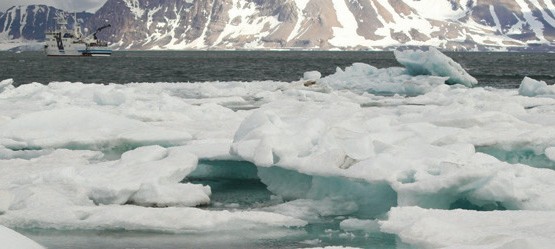How Does Changing Sea Ice Impact Mercury Levels in the Arctic?

by Mary Rose Thomas-Glaser
In recent years, the frequency of sea ice opening and closing in the Arctic Ocean has been escalating. The result of increased ice break activity is a shift from thick perennial ice masses to thinner seasonal ice sheets. Does this change in ice breaks and ice thickness affect concentrations of pollutants such as mercury in the air, water and on the ground? The answer, it seems, depends on the scientific study.
Increased Ice Breaks and Rising Mercury Levels
Based on findings from the 2012NASA Bromine, Ozone and MercuryExperiment off the coast of Alaska,turbulence in the polar air abovelarge cracks in the Arctic ice may bepulling atmospheric mercury down tothe ground surface, allowing it to enterthe food chain. Project researchersbelieve that the temperature difference between warmer seawater in the ice channels, or leads, and the layer of cold air up to 400 meters above the water causes a pumping reaction that draws down atmospheric mercury.
Warmer Air, Decreased Ice and Declining Mercury Levels
A first-of-its-kind study by the U.S. National Science Foundation and China Scholarship Council compared the impact of environmental variables such as temperature, sea ice extent and wind speed in two regions, using computer modeling to simulate recorded levels of mercury in air and water from 2000 to 2009. The findings, published in the August 2015 Geophysical Research Letters, suggested that warmer springtime temperatures and decreased Arctic ice levels, Arctic reduced mercury deposits from the atmosphere to the ocean.
Since more water is open to contact with the air from summer through fall, mercury is transferred from the water to the atmosphere. The end result, according to study scientists, is less mercury in the Arctic ocean than 10 years ago, an annual decline of about 0.67 percent for the 10-year period. “Because climate scenarios suggest that climate warming in future decades will increase surface air temperatures and decrease sea ice extent, we think it might drive substantial declines in Arctic Ocean mercury in the future,” said Long Chen, doctoral candidate at Peking University and lead study author.
In reviewing the study, Associate Professor Steve Brooks at the University of Tennessee Space Institute stated, “The reduction in ocean mercury predicted by the model should be seen as good news. It means that there is less mercury in the ocean that can wind up in the food chain.”
Classroom Discussion
- How do pollutants in the food chain affect humans?
- What are sources of mercury in the environment?
Vocabulary:
- Food Chain
- Computer Modeling
- Arctic